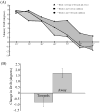Biased feedback in spatial recall yields a violation of delta rule learning
- PMID: 20702881
- PMCID: PMC2921657
- DOI: 10.3758/PBR.17.4.581
Biased feedback in spatial recall yields a violation of delta rule learning
Abstract
This study investigates whether inductive processes influencing spatial memory performance generalize to supervised learning scenarios with differential feedback. After providing a location memory response in a spatial recall task, participants received visual feedback showing the target location. In critical blocks, feedback was systematically biased either 4 degrees toward the vertical axis (toward condition) or 4 degrees farther away from the vertical axis (away condition). Results showed that the weaker teaching signal (i.e., a smaller difference between the remembered location and the feedback location) produced a stronger experience-dependent change over blocks in the away condition than in the toward condition. This violates delta rule learning. Subsequent simulations of the dynamic field theory of spatial cognition provide a theoretically unified account of these results.
Figures





References
-
- Erlhagen W, Bastian A, Jancke D, Riehle A, Schöner G. The distribution of neuronal population activation (DPA) as a tool to study interaction and integration in cortical representations. Journal of Neuroscience Methods. 1999;94:53–66. - PubMed
-
- Herzog MH, Fahle M. The role of feedback in learning a vernier discrimination task. Vision Research. 1997;37:2133–2141. - PubMed
-
- Herzog MH, Fahle M. Effects of biased feedback on learning and deciding in a vernier discrimination task. Vision Research. 1999;39:4232–4243. - PubMed
-
- Huttenlocher J, Hedges L, Corrigan B, Crawford LE. Spatial categories and the estimation of location. Cognition. 2004;93:75–97. - PubMed
-
- Huttenlocher J, Hedges LV, Duncan S. Categories and particulars: Prototype effects in estimating spatial location. Psychological Review. 1991;98:352–376. - PubMed
Publication types
MeSH terms
Grants and funding
LinkOut - more resources
Full Text Sources
